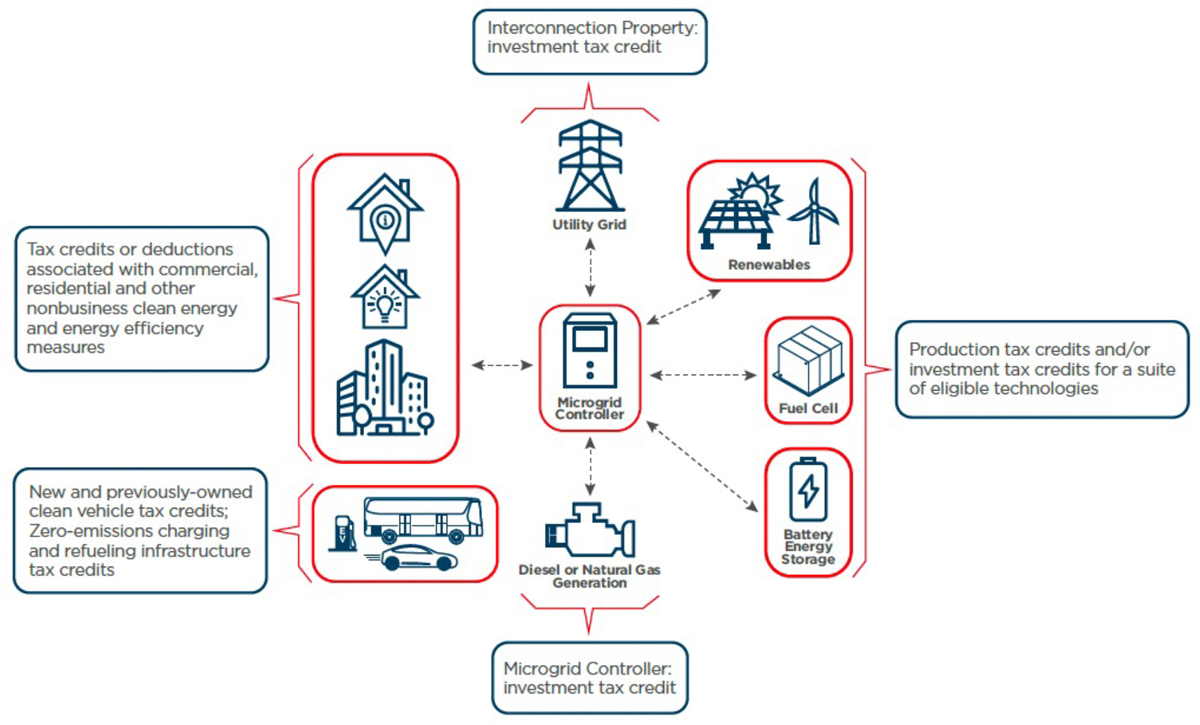PowerSecure is the nation’s leading distributed energy innovation company. Our team of experts has developed, installed, managed and serviced more than 2 GW of microgrid capacity and implemented over $900 million of energy efficiency upgrades. With all the speculation and analysis about impacts of the Inflation Reduction Act (IRA) on energy technology and infrastructure development, we know you have questions about how your distributed energy projects may be impacted. As an industry-leading microgrid solutions provider, PowerSecure can help you navigate the new landscape and leverage available savings through the IRA.
Here we break down the core elements of the IRA, its real-world applications for microgrid development, and why now is the time to realize the best return on investment (ROI) for your distributed energy assets.
Energy Investment Implications of the IRA
The Inflation Reduction Act (IRA) was passed in 2022. The wide-ranging legislation contained several elements that influence the cost of production, procurement, and installation of energy technologies. In short, the IRA has two broad impacts on microgrid development projects.
- It provides numerous federal tax credits and incentives to produce and purchase an expanded range of energy technologies at a lower cost for the next ten years
- It expands financing and monetization options for investors and non-tax-paying entities such states and tribal governments, as well as municipal, university, school, and hospitals
Key Energy Investment Elements of the IRA
First-Ever Tax Credits for Microgrid Components Will Cut Costs by 10%-50%
- Expands Investment Tax Credit (ITC) by 30% for microgrid controllers, stand-alone energy storage, biogas property, dynamic gas, and linear generators constructed before January 1, 2025.
- Bonus credits available for projects that meet domestic manufacturing and/or siting criteria.
Incentives for Clean Energy Production and Technologies Through 2032
- Extension of Renewable Electricity Production Tax Credit (PTC) through 2024
- Establishes a new, technology-neutral Clean Energy Production Tax Credit (PTC) through 2032
- $27B clean energy technology accelerator for investments in technologies and energy efficiency improvements.
Easier and More Attractive Finance Opportunities
- Direct pay for states, localities, tribes, rural cooperatives, and nonprofits for the renewable ITC and PTC
(upfront cash payment in lieu of claiming certain energy tax credits) - Tax credit transferability (ability for investors to sell tax credits to third parties)
- $30B in targeted gran programs for states and electric utilities to accelerate the transition to clean electricity
More Resources:
- U.S. Department of Energy Summary on IRA Energy and Climate Provisions
Product Example: Microgrid Controllers
A Limited Window for Maximum Savings on a Critical Component
As an example, here we’ll consider how the IRA applies to one of the most important elements of a microgrid system, the controller. The controller is important to consider now not only because of its critical role in the microgrid, but also because the incentives for the controller only apply to projects that begin construction before 2025.
A microgrid controller is the brain of your system. As the name implies, it’s the component that controls the flow of energy from diversified energy supply sources on your system and balances the delivery and consumption of electric power on a real-time basis. The controller networks with all metering systems and protective devices, centralizing performance data and alert notifications across the microgrid. Providing real-time performance analytics and management capability, the microgrid controller is what allows you to optimize system performance and realize carbon-footprint reduction and economic savings goals.
Developers who begin construction of a microgrid between 4 kilowatts and 20 megawatts before 2025 can get a 6% investment tax credit applied to the initial, up-front investment associated with the microgrid controller, plus a bonus rate of 30% if prevailing wage and apprenticeship requirements are met. Projects under 1 megawatt (AC) automatically qualify for the bonus rate. With pathways to secure additional tax credits through siting and component considerations, some projects can realize up to 50% in investment tax credits for their projects.

The IRA Has Implications for All Microgrid Components
The IRA provides incentives and support for all manner of new energy sources. It supports investments in production and procurement of biofuels, hydrogen, wind, solar, and storage assets. This feature aligns well with PowerSecure’s flexible, power source-agnostic technologies made possible with Microgrid+ solutions.
The graphic below illustrates how different microgrid elements are impacted through incentives under the IRA. These include a suite of distributed energy resources, controllers, integrated equipment, and transmission and distribution assets. Although the relevant incentives touch each component through different phases of their life cycle, the overall impact is reduced cost for building out the microgrid system and better ROI for the owner.
Distributed Energy Solutions Impacted by the IRA (shown in red)

Act Now with PowerSecure to Realize Maximum Savings
Through a range of incentives and financing reforms for domestic manufacturing, procurement, and deployment of clean energy technology, the Inflation Reduction Act is projected to reduce microgrid development costs significantly over the next decade. However, some of the available incentives will expire in 2025. With a limited window to realize maximum savings, the time to act is now
With PowerSecure as your energy partner, you can move quickly to get your project online while designing for flexibility and innovation as technology and your needs evolve. Reach out today to connect with our team of subject-matter experts to learn more, keep the conversation going, and get your microgrid project moving.
Contact a PowerSecure Representative
Click here to view/download the PDF version of this resource.



